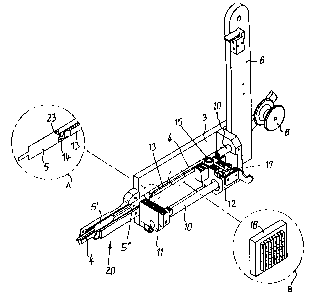Some of the information on this Web page has been provided by external sources. The Government of Canada is not responsible for the accuracy, reliability or currency of the information supplied by external sources. Users wishing to rely upon this information should consult directly with the source of the information. Content provided by external sources is not subject to official languages, privacy and accessibility requirements.
Any discrepancies in the text and image of the Claims and Abstract are due to differing posting times. Text of the Claims and Abstract are posted:
| (12) Patent Application: | (11) CA 2360254 |
|---|---|
| (54) English Title: | PRINTING AND DELIVERY DEVICE FOR LABEL TAGS |
| (54) French Title: | DISPOSITIF D'IMPRESSION ET D'ACHEMINEMENT POUR DES ETIQUETTES A ATTACHER |
| Status: | Deemed Abandoned and Beyond the Period of Reinstatement - Pending Response to Notice of Disregarded Communication |
| (51) International Patent Classification (IPC): |
|
|---|---|
| (72) Inventors : |
|
| (73) Owners : |
|
| (71) Applicants : |
|
| (74) Agent: | ROBIC AGENCE PI S.E.C./ROBIC IP AGENCY LP |
| (74) Associate agent: | |
| (45) Issued: | |
| (86) PCT Filing Date: | 2000-01-13 |
| (87) Open to Public Inspection: | 2000-07-20 |
| Availability of licence: | N/A |
| Dedicated to the Public: | N/A |
| (25) Language of filing: | English |
| Patent Cooperation Treaty (PCT): | Yes |
|---|---|
| (86) PCT Filing Number: | PCT/EP2000/000298 |
| (87) International Publication Number: | WO 2000041934 |
| (85) National Entry: | 2001-07-13 |
| (30) Application Priority Data: | ||||||
|---|---|---|---|---|---|---|
|
The invention relates to a device for printing and delivering semi-rigid tag-
type labels (5) to packaging and sealing machines. Said device comprises a
feed unit having a finger (13) which moves linearly to and fro and during the
working stroke grasps a shoulder of the label concerned and advances said
label along a defined trajectory. During the return stroke it glides over the
next label and grasps the shoulder of said label at the end of the return
stroke. This ensures that each tag-type label is correctly printed and
delivered for attachment to the object to be labeled. Preferably, one label at
a time from a chain of labels connected by perforations is cyclically moved
from a ready position into a peel-off position and the next label is printed
during the return stroke.
L'invention concerne un dispositif pour imprimer des étiquettes à attacher (5) et les acheminer à des sertisseuses-empaqueteuses. Dans ce dispositif, une unité d'avance présente un doigt (13) animé d'un mouvement de translation alternatif, qui, lorsqu'il effectue une course de travail, saisit par l'arrière une partie postérieure d'une étiquette respective et fait avancer cette dernière sur un trajet défini, tandis qu'il glisse sur l'étiquette suivante, lors de sa course de retour, jusqu'à ce qu'il saisisse par l'arrière la partie postérieure de l'étiquette suivante, à la fin de sa course de retour. Ce mode de fonctionnement assure l'impression correcte de chaque étiquette individuelle et l'acheminement de cette dernière pour qu'elle soit fixée sur l'objet à étiqueter. Selon l'invention, une étiquette, provenant d'une chaîne d'étiquettes suspendues les unes à côté des autres par l'intermédiaire de perforations, quitte à chaque fois une position de mise à disposition pour venir occuper une position de retrait, et l'étiquette suivante est imprimée pendant la course de retour.
Note: Claims are shown in the official language in which they were submitted.
Note: Descriptions are shown in the official language in which they were submitted.

2024-08-01:As part of the Next Generation Patents (NGP) transition, the Canadian Patents Database (CPD) now contains a more detailed Event History, which replicates the Event Log of our new back-office solution.
Please note that "Inactive:" events refers to events no longer in use in our new back-office solution.
For a clearer understanding of the status of the application/patent presented on this page, the site Disclaimer , as well as the definitions for Patent , Event History , Maintenance Fee and Payment History should be consulted.
| Description | Date |
|---|---|
| Inactive: IPC from MCD | 2006-03-12 |
| Application Not Reinstated by Deadline | 2004-01-13 |
| Time Limit for Reversal Expired | 2004-01-13 |
| Deemed Abandoned - Failure to Respond to Maintenance Fee Notice | 2003-01-13 |
| Letter Sent | 2002-08-15 |
| Inactive: Single transfer | 2002-06-25 |
| Inactive: Cover page published | 2001-12-10 |
| Inactive: Courtesy letter - Evidence | 2001-11-20 |
| Inactive: Notice - National entry - No RFE | 2001-11-19 |
| Inactive: First IPC assigned | 2001-11-19 |
| Application Received - PCT | 2001-11-08 |
| Application Published (Open to Public Inspection) | 2000-07-20 |
| Abandonment Date | Reason | Reinstatement Date |
|---|---|---|
| 2003-01-13 |
The last payment was received on 2002-01-10
Note : If the full payment has not been received on or before the date indicated, a further fee may be required which may be one of the following
Please refer to the CIPO Patent Fees web page to see all current fee amounts.
| Fee Type | Anniversary Year | Due Date | Paid Date |
|---|---|---|---|
| Basic national fee - standard | 2001-07-13 | ||
| MF (application, 2nd anniv.) - standard | 02 | 2002-01-14 | 2002-01-10 |
| Registration of a document | 2002-06-25 |
Note: Records showing the ownership history in alphabetical order.
| Current Owners on Record |
|---|
| POLY-CLIP SYSTEM GMBH & CO. KG |
| Past Owners on Record |
|---|
| EGGO HASCHKE |